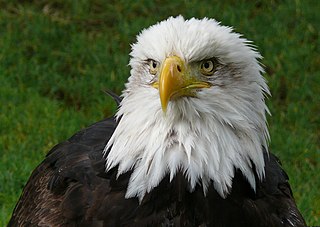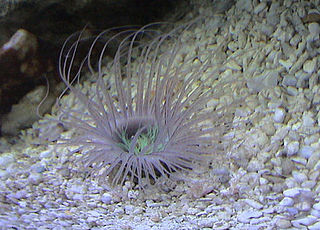Related Research Articles

Eagle is the common name for many large birds of prey of the family Accipitridae. Eagles belong to several groups of genera, some of which are closely related. Most of the 60 species of eagle are from Eurasia and Africa. Outside this area, just 14 species can be found—2 in North America, 9 in Central and South America, and 3 in Australia. It is nicknamed the king of all birds.
Genus is a taxonomic rank used in the biological classification of living and fossil organisms as well as viruses, in biology. In the hierarchy of biological classification, genus comes above species and below family. In binomial nomenclature, the genus name forms the first part of the binomial species name for each species within the genus.

In taxonomy, binomial nomenclature, also called binominal nomenclature or binary nomenclature, is a formal system of naming species of living things by giving each a name composed of two parts, both of which use Latin grammatical forms, although they can be based on words from other languages. Such a name is called a binomial name, a binomen, binominal name or a scientific name; more informally it is also called a Latin name.

Anseriformes is an order of birds that comprise about 180 living species in three families: Anhimidae, Anseranatidae, and Anatidae, the largest family, which includes over 170 species of waterfowl, among them the ducks, geese, and swans. Most modern species in the order are highly adapted for an aquatic existence at the water surface. With the exception of screamers, males have penises, a trait that has been lost in the Neoaves. Due to their aquatic nature, most species are web-footed.

Starlings are small to medium-sized passerine birds in the family Sturnidae. The name "Sturnidae" comes from the Latin word for starling, sturnus. Many Asian species, particularly the larger ones, are called mynas, and many African species are known as glossy starlings because of their iridescent plumage. Starlings are native to Europe, Asia and Africa, as well as northern Australia and the islands of the tropical Pacific. Several European and Asian species have been introduced to these areas as well as North America, Hawaii and New Zealand, where they generally compete for habitats with native birds and are considered to be invasive species. The starling species familiar to most people in Europe and North America is the common starling, and throughout much of Asia and the Pacific, the common myna is indeed common.
In biology, a monotypic taxon is a taxonomic group (taxon) that contains only one immediately subordinate taxon.

In zoological nomenclature, a type species is the species name with which the name of a genus or subgenus is considered to be permanently taxonomically associated, i.e., the species that contains the biological type specimen(s). A similar concept is used for suprageneric groups and called a type genus.

Tube-dwelling anemones or ceriantharians look very similar to sea anemones but belong to an entirely different subclass of anthozoans. They are solitary, living buried in soft sediments. Tube anemones live inside and can withdraw into tubes, which are composed of a fibrous material made from secreted mucus and threads of nematocyst-like organelles known as ptychocysts. Within the tubes of these ceriantharians, more than one polyp is present, which is an exceptional trait because species that create tube systems usually contain only one polyp per tube. Ceriantharians were formerly classified in the taxon Ceriantipatharia along with the black corals but have since been moved to their own subclass, Ceriantharia.

Vertiginidae, common name the whorl snails, is a family of minute, air-breathing land snails, terrestrial pulmonate gastropod molluscs or micromollusks in the superfamily Pupilloidea.

Pupillidae is a family of mostly minute, air-breathing, land snails, terrestrial pulmonate gastropod mollusks or micromollusks in the superfamily Pupilloidea.
Pronesopupa acanthinula is a species of small air-breathing land snail, a terrestrial pulmonate gastropod mollusk in the family Pupillidae. This species is endemic to Hawaii.
Pronesopupa boettgeri is a species of air-breathing land snail, a terrestrial pulmonate gastropod mollusk in the family Pupillidae. This species is endemic to Hawaii.
Pronesopupa frondicella is a species of air-breathing land snail, a terrestrial pulmonate gastropod mollusk in the family Pupillidae. This species is endemic to Hawaii.
Pronesopupa hystricella is a species of air-breathing land snail, a terrestrial pulmonate gastropod mollusk in the family Pupillidae. This species is endemic to Hawaii.
Pronesopupa incerta is a species of small air-breathing land snail, a terrestrial pulmonate gastropod mollusk in the family Pupillidae. This species is endemic to Hawaii.
Pronesopupa lymaniana is a species of small air-breathing land snail, a terrestrial pulmonate gastropod mollusk in the family Pupillidae. This species is endemic to Hawaii.
Pronesopupa molokaiensis is a species of small air-breathing land snail, a terrestrial pulmonate gastropod mollusk in the family Pupillidae. This species is endemic to Hawaii.
Pronesopupa orycta is a species of small air-breathing land snail, a terrestrial pulmonate gastropod mollusk in the family Pupillidae. This species is endemic to Hawaii.
Pronesopupa sericata is a species of small air-breathing land snail, a terrestrial pulmonate gastropod mollusk in the family Pupillidae. This species is endemic to Hawaii.

In biological classification, taxonomic rank is the relative level of a group of organisms in a taxonomic hierarchy. Examples of taxonomic ranks are species, genus, family, order, class, phylum, kingdom, domain, etc.
References
- ↑ Iredale T. (1913). Proc. malac. Soc. London10: 384.
| This Pupillidae-related article is a stub. You can help Wikipedia by expanding it. |